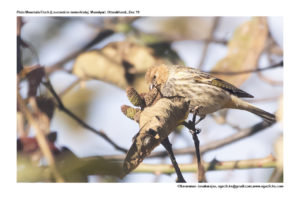
Plain Mountain Finch Leucosticte nemoricola
Etymology:
Nominate:
- Leucosticte : Greek word leukos –white; stiktos- spotted { White Spotted}
- Nemoricola : Latin word nemoris – forest, wood ; cola –dweller
Sub-species:
- L.n. altaica : From Altai mountains
Distribution in India:
- Nominate – Himalayas to West Arunachal Pradesh
- L.n. altaica – North India ( Uttarakhand)
Description: Size of 14–15 cm; wt. of 18–25·5 g. It is a medium-sized to large, slender, brownish finch with pointed bill, long wings and notched tail. The nominate race in breeding plumage has head brown or dark gingery brown, finely streaked darker on forehead and crown, slightly paler or buffish-brown over eye and ear-coverts with poorly defined supercilium. The hindcrown to nape is dark brown fading to buff-brown on lower nape and side of neck. The upperparts are dark warm brown, broadly streaked paler tawny-buff, pale buff edges forming “tramlines” at sides of mantle and back. The lower back and rump are paler or greyer, uppertail-coverts are dark grey, tipped paler, longest covert tipped white or whitish. The tail is dark brown, finely edged buff; upperwing is dark brown, median coverts are brown with blackish centres and white tips, greater coverts are dark brown with buff to white tips, mainly paler brown outer webs of outer feathers, alula and primary coverts are finely edged whitish. The flight-feathers are edged warm brown, or paler on inner secondaries, tertials are broadly edged warm brown and tipped light buff. The throat and underparts are pale grey-brown, duller brown in fresh plumage. The vent and undertail-coverts are whitish, tipped greyish; axillaries are pale to deep yellow. The iris is bright red to reddish-brown or black; bill is brown or brownish-horn, paler base of lower mandible. The legs are dark brown. The non-breeding plumage is duller, with pale buff tips reduced or absent, creating more uniform or less prominently streaked appearance. The sexes are alike. The juvenile is similar to adult, but paler or warmer brown, crown and face are dark rufous-brown, finely streaked paler, upperparts are less heavily streaked and feathers are edged warmer rufous-brown, tips of median and greater upperwing-coverts are whitish or whitish-buff, underparts are gingery brown, finely streaked darker, belly to undertail-coverts are paler. The first-year is like adult, but retains rich brown on crown and ear-coverts and edges of upperparts. Race altaica differs from nominate in having head and upperparts slightly more rufous-brown with darker brown centres, underparts are paler, axillaries are pale grey or greyish-white, juvenile and first-winter also deep ginger or rich warm brown on underparts.
Habitat: It is found in submontane and montane hillsides. It breeds above tree-line on open boulder-strewn ridges, slopes and plateaux and in upper forest zone with alpine meadows, pastures with dwarf bushes and scrub. It is found from 2350–5300 m. In non-breeding season found in upper edges of valleys and mountain forests, rocky hillsides, edges of cultivation, rice paddies, open fields and in and around villages; down to 2000m.
Food Habits: It eats seeds of grasses and alpine herbs; small invertebrates and seeds. The nestling diet is a mixture of plant and animal food. It forages on open ground, in grassy areas among rocks and, less frequently, in open woodland, where it perches on trees. It forages in flocks along with Common Starlings.
Breeding habits: They breed Jun–Aug. The displaying male on ground in front of female raises and holds both wings erect over back, and may run, with wings held high, towards female while giving excited calls. The nest is built by female. The nest is a shallow cup of grass, leaves, plant fibres and roots, moss, animal hair and feathers, placed above ground in hole or rocky crevice or beneath rocks, boulders or heap of stones. They lay a clutch of 3–6 eggs. The incubation is done by female, male feeds the female in the nest. The incubation period is 13–15 days. The chicks are fed and cared for by both parents. The nestling period is 15–19 days